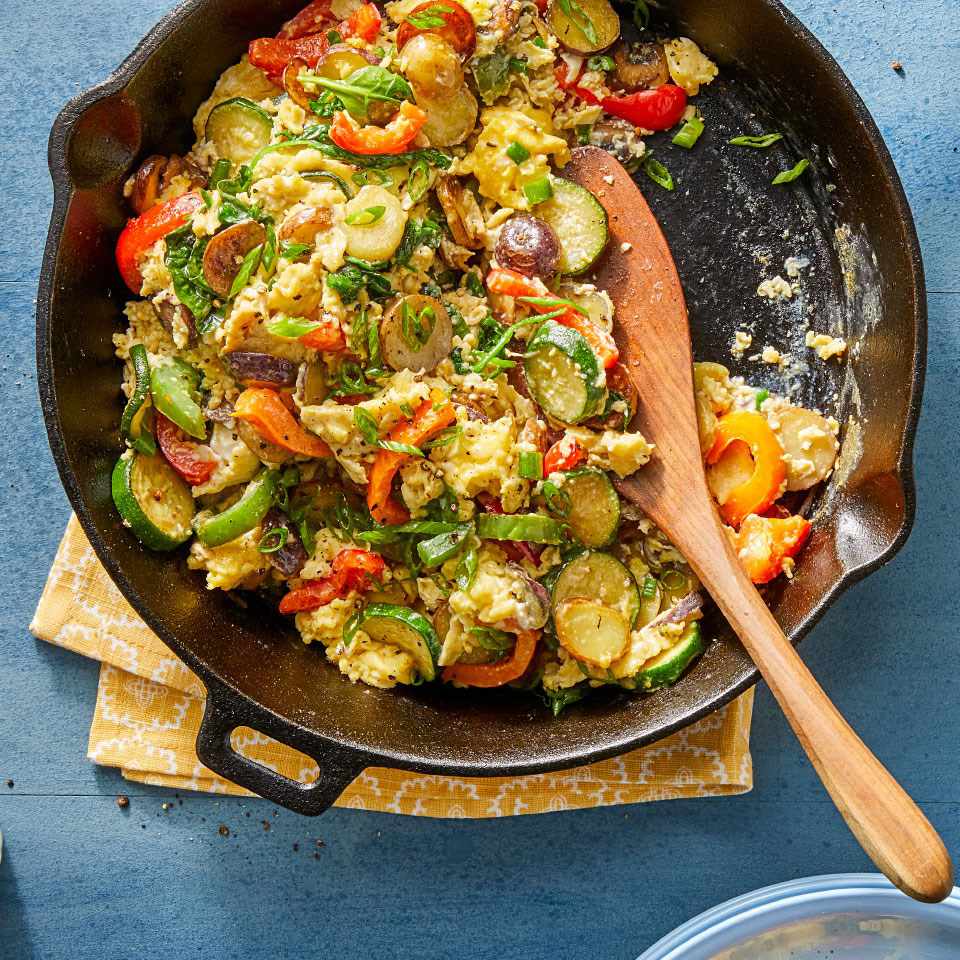Half of all adults in the United States have high blood pressure (AKA hypertension) and may not even know it, according to National Heart, Lung and Blood Institute (LNHBI). What you eat throughout the day, including breakfast, can play a role in managing high blood pressure. This is why the DASH (Dietary Approaches to Stop Hypertension) eating plan was created. Below is an explanation of the DASH diet and what breakfast to eat if you have high blood pressure.
Illustrated recipe: Summer Vegetable and Scrambled Egg Skillet
What is high blood pressure?
You have high blood pressure if blood is flowing through your arteries at higher than normal pressure. If you have looked at your blood pressure reading. The top number is systolic, or the blood pressure pumped out of the heart. The bottom number is diastolic, or the pressure between heartbeats.
Your blood pressure changes throughout the day depending on your activities. According to American Heart Association, normal blood pressure is when your systolic number is below 120 mm Hg and your diastolic number is below 80 mm Hg (or 120/80 mm Hg). High blood pressure is considered when your blood pressure has a constant systolic number of at least 130 mm Hg or a diastolic number of 80 mm Hg or more.
Controlling or lowering your blood pressure can help delay or prevent health problems like heart attacks, chronic kidney disease, heart failure, and strokes. To help control high blood pressure, a heart-healthy lifestyle is recommended. This includes choosing heart-healthy foods like those on the DASH diet.
The History of the DASH Diet
The DASH diet began in 1997 when health professionals recognized that obesity, along with high salt and alcohol intake, affected blood pressure. However, the researchers didn’t want to focus on any specific food or nutrient to avoid. Instead, they wanted to study the effects of healthy, inexpensive foods that promote good health and lower blood pressure.
The landmark clinical trial was published in 1997 in the New England Journal of Medicine. In this randomized controlled trial, the researchers divided the participants into three3 groups: a control diet (low in fruits, vegetables and dairy products), a diet rich in fruits and vegetables or a “combined” diet which included fruits, vegetables and low-fat dairy products and had reduced total and saturated fats. Researchers found that people with and without high blood pressure had the most significant reduction in blood pressure when they consumed low-fat fruits, vegetables, and dairy products and reduced their saturated fat intake compared to fruits and vegetables alone or in the control diet. As a result of this study, the DASH diet was born.
What is the DASH Eating Plan?
The DASH meal plan provides daily and weekly nutritional goals using healthy, affordable foods that you can find at your local market. The plan recommends eating fruits, vegetables and whole grains, and includes fat-free or low-fat dairy products, fish, poultry, beans, nuts and vegetable oils. The plan limits foods high in saturated fat, including fatty meats, whole dairy products, and tropical oils, such as coconut and palm oils. It also limits sugary drinks (like sodas) and sweets.
Below are the target daily and weekly servings for the DASH Eating Plan, based on a 2,000 calorie diet, according to the NHLBI:
| food group | Daily servings |
| Cereals | 6-8 |
| Meat, poultry and fish | 6 or less |
| Vegetables | 4-5 |
| Fruits | 4-5 |
| Fat-free or low-fat dairy products | 2-3 |
| Fats and oils | 2-3 |
| Sodium | 2300mg (ideally 1500mg) |
| food group | Weekly servings |
| Nuts, seeds, dried beans and peas | 4-5 |
| Candy | 5 or less |
The best breakfast for high blood pressure
When it comes to a DASH breakfast, this Summer Skillet Vegetable & Egg Scramble does a good job of including healthy foods in the meal plan and is a top choice for breakfast for high blood pressure. The bowl contains eggs for protein, a variety of vegetables (anything you have on hand, really!), and potatoes for carbs. Since fruit is important in the DASH diet, pair it with 1 cup of strawberries or blueberries or enjoy fruit for your mid-morning snack.
What about lunch and dinner?
Enjoying heart-healthy meals the rest of the day is also important. Choose foods low in saturated fat, high in potassium, calcium, magnesium, fiber and protein, and low in sodium. Here are some lunch and dinner options that fit the DASH diet:
Snacks are also important
Snacks are mini-meals that provide heart-healthy nutrients between meals. If you go more than 5 hours between meals or feel hungry between meals, now is a good time for a snack. Snacks should be around 150-250 calories and you can eat 1-3 per day. Here are some heart-healthy snack options:
The essential
The DASH diet is a heart-healthy diet that can help manage or even lower your blood pressure. Breakfast should include plenty of DASH diet foods, like in the Summer Skillet Vegetable & Egg Scramble. Remember that what you eat the rest of the day matters too. Lunch, dinner, and snacks should also be part of the DASH diet to help you manage or control high blood pressure.
Thank you for your feedback!
